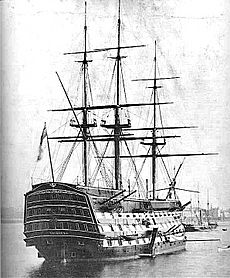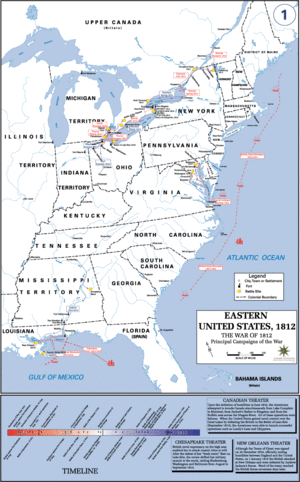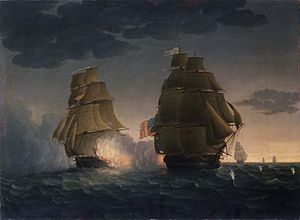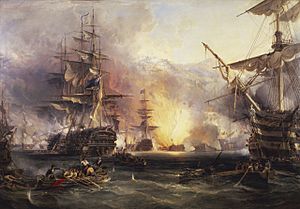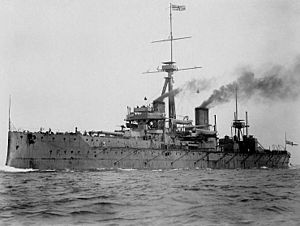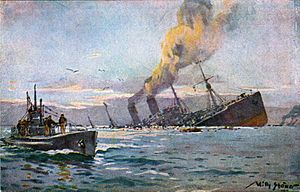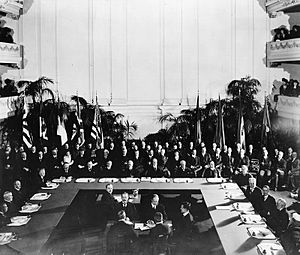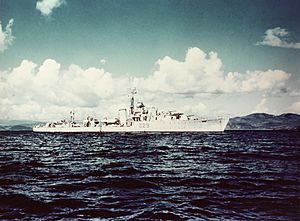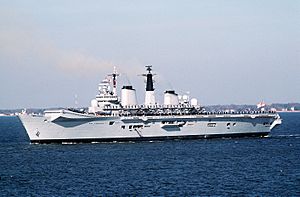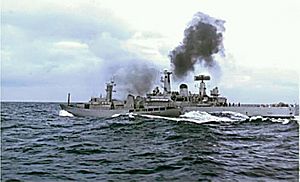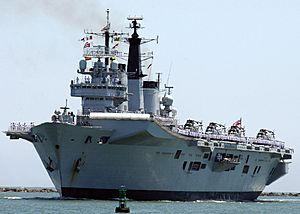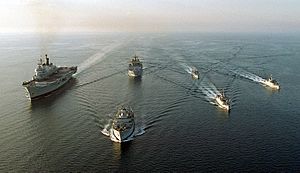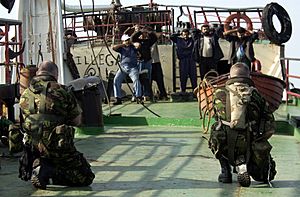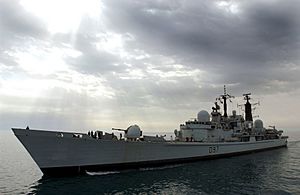History of the Royal Navy (after 1707) facts for kids
The history of the Royal Navy changed a lot in 1707. That year, the Act of Union joined the kingdoms of England and Scotland to form Great Britain. This meant the Royal Scots Navy became part of the Royal Navy.
The Navy grew a lot during the long fight with France, which started in 1690 and ended with the Napoleonic Wars. During this time, sailing ships became very advanced. After these wars, Britain had a long period of peace and ruled the seas. Ships changed from using sails to steam engines, and cannons became huge shell-firing guns. This led to a race to build bigger and better battleships. However, aircraft carriers and submarines later became more important. After World War II, the Royal Navy was no longer the world's most powerful navy, and the United States Navy took its place. Today, the Royal Navy is still one of the strongest navies, with modern ships, but its size has gotten much smaller since the 1980s.
Contents
Wars with France and Spain (1707-1748)
Before 1707, Scotland and England had separate navies. But they usually worked together as one force. In 1707, the Act of Union officially combined the Royal Scots Navy with the English Royal Navy. Some Scottish ships were renamed to avoid confusion with larger English ships. For example, Scottish frigates became HMS Edinburgh and HMS Glasgow.
The Act of Union happened during the War of Spanish Succession. The Navy worked with the Dutch to fight the navies of France and Spain. They helped Britain's allies take control of Spain's Mediterranean lands. The Anglo-Dutch fleet captured places like Sardinia, the Balearic Islands, and Barcelona. Britain kept Gibraltar and Menorca as naval bases in the Mediterranean.
Early in the war, French ships attacked English and Dutch trading ships. But a big victory at Vigo Bay in 1702, and other successes, cleared the seas of most French and Spanish ships. The Navy also helped conquer French colonies in Nova Scotia and Newfoundland. More fighting with Spain happened in the War of the Quadruple Alliance (1718–1720). The Navy helped stop Spain from taking back Sicily and Sardinia, winning a battle at Cape Passaro in 1718.
The next 25 years were mostly peaceful, but the Navy still had some missions. It protected naval supplies in the Baltic from 1715 to 1727. It also helped defend Gibraltar from a Spanish attack in 1727. In 1745, the Royal Navy helped stop the Jacobite rising.
Later, the Navy fought Spain again in the War of Jenkins' Ear (1739–1748). This war involved many costly and often unsuccessful attacks on Spanish ports in the Caribbean. Many sailors died from tropical diseases. In 1742, a small British fleet made the Kingdom of the Two Sicilies leave the war by threatening to bomb its capital, Naples. This war became part of the larger War of the Austrian Succession (1744–1748), where Britain fought France again. Naval battles in this war, including in the Indian Ocean, were mostly undecided. A big event was France's failed attempt to invade England in 1744.
Seven Years' War (1756-1763)
The Seven Years' War (1756–1763) saw the Navy launch attacks that led to the capture of New France (Canada) and French colonies in the Caribbean and West Africa. Operations in the Indian Ocean helped destroy French power in India.
Admiral John Byng was executed for failing to save Minorca. This led to the famous saying by Voltaire: "in this country it is wise to kill an admiral from time to time to encourage the others." Minorca was lost, but later operations went better. The British fleet won several victories, starting with the Battle of Cartagena in 1758.
France tried to invade Britain in 1759, but their fleet was defeated at the Battle of Quiberon Bay. This defeat largely removed the French Navy from the war. Spain joined the war against Britain in 1762 but lost Havana and Manila. Manila was later returned in exchange for Florida. The Treaty of Paris ended the war.
The war showed how strong the British Navy was. France lost many ships and sailors. Spain also lost ships and men. The Royal Navy lost some ships but gained many more during the war.
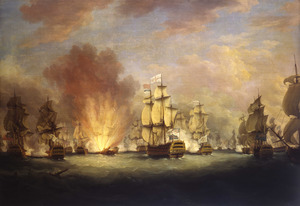
American Revolutionary War (1775-1783)
British America was important for the Royal Navy because it supplied a lot of timber. The Navy also increased its presence there to stop illegal smuggling. An incident where a British ship ran aground and was attacked in Rhode Island helped start the war.
At the beginning of the American Revolutionary War (1775–83), the Royal Navy easily defeated the new Continental Navy. However, France soon joined the American side. In 1778, a French fleet sailed to America. Spain and the Dutch Republic joined the war in 1780. A large British trading convoy was captured by a Franco-Spanish fleet in 1780, which hurt British trade.
Fighting moved to the Caribbean, with mixed results. A Spanish fleet was defeated at the Battle of Cape Saint Vincent in 1780. A Franco-Spanish fleet was defeated at the Battle of the Saintes in 1782. The most important event was in 1781 at the Battle of the Chesapeake. The British failed to break the French blockade of Lord Cornwallis, leading to a British surrender at Yorktown. This meant the Thirteen Colonies became independent.
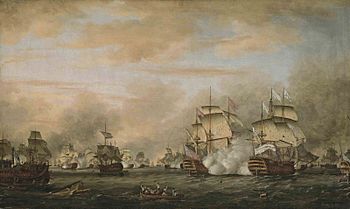
In the 1790s, scurvy was stopped in the Royal Navy thanks to Gilbert Blane. He ordered fresh lemon juice for sailors. Other navies soon copied this successful idea.
French Revolutionary and Napoleonic Wars (1793–1815)
The French Revolutionary Wars (1793–1802) and the Napoleonic Wars (1803–15) were a time when the Royal Navy was at its best. It was much stronger than the navies of Britain's enemies. In 1793, France declared war. This led to battles like the Glorious First of June and the capture of French colonies. The Dutch Republic and Spain later joined France's side.
More battles happened in 1797 and 1798, including the Battle of Cape St Vincent and the Battle of the Nile. These battles made Admiral Horatio Nelson famous. The Battle of the Nile stopped Napoleon's plan for Egypt. In 1801, Britain attacked Denmark at the Battle of Copenhagen because Denmark closed its ports to British ships.
A short peace in 1802 ended quickly, and the Navy soon blockaded Napoleon's France. In 1805, Napoleon gathered many ships to invade Britain. But the British fleet chased the French fleet, stopping their plans. The greatest achievement of the Navy came on October 21, 1805, at the Battle of Trafalgar. A smaller but more experienced British fleet led by Admiral Lord Nelson completely defeated the combined French and Spanish fleets. This victory made Britain the strongest naval power in Europe, but Nelson was killed during the battle.
By focusing on its navy, Britain could defend itself and project its power across the oceans. The Navy could also cut off enemies' supplies by sea.
Naval commands were open to talented sailors, but family connections and influence were often important for promotion. British captains recruited crews from volunteers, forced enlistment (called impressment), and existing sailors. Many different nationalities served on British ships.
Life for ordinary sailors was tough but often better than other jobs at the time. However, pay was low and often delayed. This led to serious mutinies in 1797. Sailors refused to obey orders, demanding better conditions. Some mutineers were hanged, but conditions did improve.
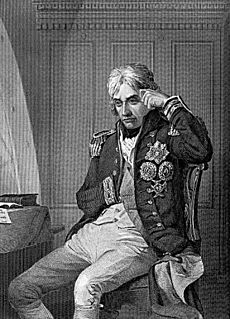
Napoleon tried to hurt Britain's trade by closing European ports. He also allowed many privateers (private ships that attacked enemy trade) to operate from French colonies. The Royal Navy was busy in Europe and couldn't send many large ships to fight these fast privateers. So, the Navy started using smaller, faster ships called sloops. The most famous was HMS Pickle, which carried the news of the victory at Trafalgar back to Britain.
The Napoleonic Wars are remembered as the peak of "fighting sail." Many stories about the Royal Navy from this time are still told today, like the Horatio Hornblower series.
War of 1812
After the Battle of Trafalgar, tensions grew between Britain and the United States. American traders tried to trade with both France and Britain, but the Royal Navy enforced blockades. Another issue was British sailors who had deserted and were serving on US ships. The Royal Navy often tried to get them back. In 1807, HMS Leopard fired on USS Chesapeake, causing casualties, to seize suspected British deserters.
In 1812, while the Napoleonic Wars continued, the United States declared war on Great Britain. Britain was busy fighting France, so it sent only enough forces to America to prevent a US victory. On land, Britain relied on local militias and Native American allies. At sea, the Royal Navy kept its large warships in Europe, using smaller ships against the weaker United States Navy. Some fighting happened on the Great Lakes.
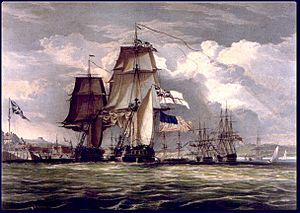
At sea, the War of 1812 involved many small ship battles and attacks on trading ships. The Royal Navy struggled to build enough ships and find trained sailors. Many British sailors were forced into service, which hurt morale. The US Navy had fewer ships but built a few better-designed frigates. These American ships were larger, heavier, and better armed than their British rivals. They also had larger volunteer crews. Because of this, some British ships were defeated. The Admiralty eventually ordered British frigates not to fight American frigates alone.
The most important part of the Royal Navy's role in the War of 1812 was its blockade of American shipping. This blockade grew stronger throughout the war, eventually covering the entire American coast. It trapped most American trading and naval ships in port. For example, the American frigates USS United States and USS Macedonian were stuck in port until the end of the war.
The blockade severely hurt the American economy. American exports dropped from $130 million in 1807 to $7 million in 1814. The blockade also forced merchants to use slow, expensive land routes instead of cheap, fast coastal trade. By 1814, only 1 out of 14 American merchant ships dared to leave port because of the high risk of capture.
Britain also used privateers, especially from Bermuda, to attack enemy ships. Bermudian privateers captured 298 enemy ships during the war.

By this time, the Royal Navy was building a large naval base and dockyard in Bermuda. This base became the year-round headquarters for the North America and West Indies Squadron. Bermuda was important because it replaced the continental bases Britain lost after American independence. During the War of 1812, the Royal Navy's blockade of US Atlantic ports was managed from Bermuda and Halifax, Nova Scotia.
The blockade kept most of the American navy in port. The Royal Navy also occupied coastal islands and encouraged American slaves to join them. Military-aged men joined the Corps of Colonial Marines, and their families were sent to Bermuda. These marines fought for Britain along the Atlantic coast and in the attack on Washington, D.C..
After Britain won the Peninsular War, some of Wellington's soldiers were sent to North America. This force, led by Major-General Robert Ross, arrived in Bermuda in 1814. They launched raids on the coasts of Maryland and Virginia to draw US forces away from the Canadian border. In response to American actions, Sir George Prevost asked for a punishment attack. The British force landed near Washington, D.C., and drove the US government out. Ross was hesitant to burn public buildings, but Rear Admiral Sir George Cockburn and others set them on fire. The US Capitol and the US President's Mansion were burned.
The Pax Britannica (1815–1914)
After 1827, there were no major naval battles until 1914. The Navy was used to attack shore targets, like during the Crimean War in the Baltic and Black Sea in 1854 and 1855. They also fought pirates, hunted down slave ships, and helped the army by sending sailors and marines ashore. With a fleet larger than any two rivals combined, Britain felt secure. Leaders and the public always supported a strong navy, and serving in it was highly respected.
The first action of this period was the 1816 bombardment of Algiers. A joint British and Dutch fleet, led by Lord Exmouth, forced the Barbary state of Algiers to free Christian slaves and stop enslaving Europeans. During the Greek War of Independence, at the Battle of Navarino in 1827, the Turkish fleet was destroyed by the combined fleets of Britain, France, and Russia. This was the last major battle between fleets of sailing ships.
To stop Russia from getting a warm-water port, the Crimean War was fought in the 1850s. Britain, with the Ottoman Empire and France, sent many ships. The Imperial Russian Navy's Black Sea Fleet was destroyed. The Crimean War tested new technologies like steam power and explosive shells. It showed that shells could destroy wooden ships, leading to the development of "iron clad" ships.
The Chinese government limited British trade. In 1839, a Chinese official seized opium from India. Britain insisted on trading and blockaded Guangzhou, starting the First Opium War. A Second Opium War followed from 1856 to 1860. Britain gained a base at Hong Kong in 1839 and in Canton in 1857.
In 1864, the bombardment of Kagoshima forced Japan to accept foreign traders. During the Russo-Turkish War, the British sent battleships to stop Russia from entering Constantinople. Later, in 1882, the fleet bombarded Alexandria to control the Suez Canal.
Technological Advancements
During this time, naval warfare changed completely. Steam power, metal ships, and explosive weapons replaced sails and old building methods. Even though the Navy had to replace its entire fleet, it stayed stronger than any other navy. Britain's lead in the Industrial Revolution gave it unmatched shipbuilding ability and money.
Steam power was first used in HMS Comet in 1822. By the 1830s and 1840s, more steam vessels appeared, using side paddlewheels. Screw propellers were introduced in the 1830s and adopted in the mid-1840s. The first major steam warship was HMS Agamemnon. In the 1850s, many screw battleships and frigates were built. These ships still had sails because steam engines were not yet efficient enough for long ocean trips. Steam was mainly for battle and to allow ships to leave port without waiting for favorable winds.
Iron was first used for bracing in warships. Iron hulls were thinner than wooden ones, but experiments showed that iron could shatter under impact. In 1858, France built the first seagoing ironclad, Gloire. Britain responded with Warrior in 1860. This started a race to build more armored ships, which Britain won by 1870.
When armored ships first appeared, guns could barely penetrate their armor. But after 1867, new guns could pierce the armor of early ironclads. This led to a "gun calibre-race" as bigger guns were needed for better penetration. Explosive shells were introduced in 1820.
There was also a debate about how to mount guns. Captain Cowper Coles developed a gun turret design. Early designs had many turrets. Coastal turret-ships were built alongside seagoing ironclads. The Admiralty's design, Monarch (1868), had a successful career. Later, Devastation (1871) solved problems by having large coal bunkers and placing heavy guns in turrets.
New technologies included tank testing of hull models and mechanical calculators for range finding. The torpedo appeared in the 1870s, leading to torpedo boats and later destroyers.
Palmerston Forts (1860-1869)
In the 1860s, fear of a French invasion led to a big program of coastal forts. Over 70 forts were built, many near the naval base in Portsmouth. Some, like Fort Brockhurst, were outdated before they were even finished because technology changed so fast. France was weakened by its defeat in the 1870 Franco-Prussian war. Britain would not face a serious military threat until the World Wars, by which time these forts were very old. They were often called "Palmerston's Follies."
Two-Power Standard
Naval dominance became more expensive as other countries like France, Germany, and Japan built stronger navies. To respond, Britain passed the Naval Defence Act 1889 in 1889. This law formally adopted the "two-power standard." It meant the Royal Navy had to be as strong as the next two largest navies combined (at that time, France and Russia).
This led to a new shipbuilding program, including ten new battleships and 38 cruisers. Books by American Alfred Thayer Mahan and his visit to Europe in the 1890s increased interest in naval power. When Prime Minister William Ewart Gladstone opposed another large naval building program in 1894, he resigned.
At this time, 80% of merchant steamships were built in British shipyards. French shipbuilding was slow. Reports in magazines like Pall Mall Gazette in 1884 wrongly suggested France had more new battleships than Britain. This alarmed the public and increased interest in naval books. Conditions for enlisted men also improved, with military flogging being abolished in 1879.
The two-power standard was dropped before World War I. After the war, it was replaced by a "one-power standard," meaning the Navy would be equal in size to the United States Navy.
Reforms and Growing Tension (1901-1914)
Naval building and strategy became very intense. The development of torpedoes and submarines (from 1901) challenged old ideas about battleships. At the same time, Dreadnought introduced the "big gun only" idea, changing naval thinking worldwide. This ship had ten 12-inch guns and was very fast, making all older battleships obsolete.
Germany's industrial growth allowed its Imperial German Navy to try to build more dreadnoughts than Britain. In the resulting arms race, Britain kept a significant lead over Germany. But for the first time since 1805, another navy could challenge the Royal Navy in battle.
The British learned from Japanese naval observers at the battle of Tsushima straits in 1905, where Japan defeated the Russian fleet. Another new idea was the battlecruiser, which had battleship-level guns but was faster. However, to be faster, it had less armor, which was a weakness in battle.
The Royal Navy started developing submarines on February 4, 1901. These were built by Vickers under a license from an American company. The first British submarine was 63 feet 4 inches long.
Major reforms were made to the British fleet, especially by Admiral Jackie Fisher from 1904 to 1909. He scrapped 154 old ships, including 17 battleships, to make way for newer ones. Training and gunnery were improved. Changes in British foreign policy, like better relations with the United States and alliances with Japan and France, allowed the fleet to be concentrated in home waters. By 1906, the Imperial German Navy was the Royal Navy's only likely opponent.
Some countries in the British Empire started their own navies. In 1910, the Royal Australian Navy and the Royal Canadian Navy were formed. These local forces would work within Britain's overall naval strategy. All these changes and new ships required a big increase in funding. Between 1900 and 1913, naval spending almost doubled.
First World War (1914–1918)
The tensions between countries finally led to World War I. Navies were expected to fight big battles, but caution meant few major engagements at sea. The Royal Navy and the Kaiserliche Marine (German Navy) fought many smaller battles, like the Battle of Heligoland Bight and the Battle of the Falkland Islands. The one huge confrontation was the Battle of Jutland in 1916. The British blockade of Germany led to public unhappiness and eventually the German Revolution. The British naval advantage was too great, and the German High Seas Fleet stopped trying to challenge British dominance.
Blockade of Germany
Most of the Royal Navy's strength was in the Grand Fleet at home. Its goal was to blockade Germany and force the German "High Seas Fleet" into a decisive battle. The Navy's Northern Patrol and mining operations closed off access to the North Sea. The Dover Patrol closed off the English Channel. This blockade stopped the Imperial German Navy from reaching the Atlantic and largely blocked neutral trading ships going to or from Germany. The blockade continued for eight months after the armistice to force Germany to sign the Treaty of Versailles.
Protecting Merchant Ships
The biggest threat to the Navy came from German U-boats (submarines) attacking merchant ships. For much of the war, submarines had to warn merchant ships and let crews evacuate before sinking them. In 1915, Germany removed these rules and began sinking ships without warning. But they later returned to the old rules to calm neutral countries. When Germany resumed unrestricted submarine warfare in 1917, Britain and its allies faced being starved into surrender.
The Navy's response was slow because it refused to use a convoy system (where merchant ships travel together with escorts), even though it worked well for troopships. When convoys were finally introduced, losses dropped sharply, and the U-boat threat was controlled.
Oil was vital for Britain's war effort. All oil was imported since Britain had no oil wells. The Royal Navy's fuel oil was top priority. The need for oil also led to Britain taking control of Iraq after the war.
Other Campaigns
At the start of the war, Germany had armed cruisers around the world. The Royal Navy and the Royal Australian Navy captured German colonies in the Pacific. This forced the German East Asia Squadron to leave its base. This squadron was eventually defeated at the Battle of the Falkland Islands in December 1914.
The Royal Navy was also heavily involved in the Dardanelles Campaign against the Ottoman Empire. It suffered heavy losses trying to break through minefields and shore defenses.
The Navy also contributed the Royal Naval Division to the land forces. The Royal Marines took part in many operations, including a raid on Zeebrugge.
The Royal Naval Air Service was formed in 1914, mostly for scouting. The first purpose-built aircraft carrier, HMS Argus, was launched in 1918.
Between the World Wars (1918-1939)
In 1921, the New Zealand Division of the Royal Navy was created as a New Zealand force within the Royal Navy.
Disarmament and Pay Cuts (1922-1935)
After World War I, countries wanted to reduce their weapons. The Washington Naval Treaty of 1922 limited the size and number of warships. This treaty, along with financial problems and the Great Depression, forced the Admiralty to scrap many large ships and cancel plans for new ones. For example, three large battlecruisers were canceled. Only a few new major ships were built in the 1920s, like two Nelson-class battleships and some cruisers. The 1930 London Naval Treaty further limited new warship construction until 1937.
There were big pay cuts in the 1920s, up to 25% for some sailors. This led to the Invergordon Mutiny of 1931, where crews of several warships refused to sail. This caused a huge shock. Pay cuts were reduced to 10%, but about 200 sailors were jailed.
One-Power Standard
By 1922, facing the growing United States Navy, the British Navy adopted the "one-power standard." This meant the Royal Navy had to be equal in size to the United States Navy. British naval supremacy was lost in 1943, when the United States Navy became larger during World War II.
Tensions and Arms Race (1937-1939)
As international tensions rose in the mid-1930s, the Second London Naval Treaty of 1935 failed to stop a naval arms race. By 1938, treaty limits were mostly ignored. The Royal Navy was already rebuilding, with new battleships and its first full-sized aircraft carriers under construction. Old battleships and cruisers were rebuilt and given stronger anti-aircraft weapons. New technologies like ASDIC (for detecting submarines) and Huff-Duff (for finding radio signals) were developed. The Navy had lost control of naval aviation in 1918, but it regained control of ship-based aircraft in 1937.
The Navy showed its strength against Mussolini's war in Abyssinia. It also helped evacuate British citizens from Chinese cities attacked by Japan during the Second Sino-Japanese War.
Second World War (1939-1945)
At the start of the war in 1939, the Royal Navy was the largest in the world, with over 1,400 ships. It had:
- 7 aircraft carriers (with 5 more being built)
- 15 battleships and battlecruisers (with 5 more being built)
- 66 cruisers (with 23 more being built)
- 184 destroyers (with 52 being built)
- 60 submarines (with 9 being built)
The Royal Navy suffered heavy losses in the first two years. This included carriers like Courageous and Ark Royal, and battleships like Royal Oak and Hood. Over 3,000 people were lost when the troopship RMS Lancastria was sunk in June 1940, the biggest maritime disaster in British history. However, there were also successes against enemy ships, like at the battles of the River Plate in 1939 and Cape Matapan in 1941. They also sank the German battleships Bismarck in 1941 and Scharnhorst in 1943.
The Coastal Forces and the Royal Naval Patrol Service were responsible for defending ports and keeping sea lanes open around the coast.
Battle of the Atlantic (1939-1945)
The Navy's most important fight was the Battle of the Atlantic. It defended Britain's vital supply lines against U-boat attacks. A traditional convoy system was used from the start. But German "wolf-pack" tactics (group attacks by submarines) were very effective. The threat remained serious for over three years.
Defenses were improved with special escort ships, escort carriers, long-range patrol aircraft, better anti-submarine weapons, and the decoding of German Enigma signals by Bletchley Park. The U-boat threat was finally broken in the spring of 1943, when many U-boats were destroyed. Intense convoy battles also happened in the Arctic (supplying Russia) and the Mediterranean (supplying Malta).
Operation Dynamo (1940)
Early in the war, the Royal Navy provided crucial cover during Operation Dynamo. This was the British evacuation from Dunkirk. It also acted as the main defense against a German invasion of Britain. At Taranto, Admiral Cunningham led a fleet that launched the first all-aircraft naval attack in history. Cunningham wanted the Navy to be seen as Britain's most daring military force. When warned about risks during the evacuation after the Battle of Crete, he said, "It takes the Navy three years to build a new ship. It will take three hundred years to build a new tradition. The evacuation will continue."
Amphibious Operations
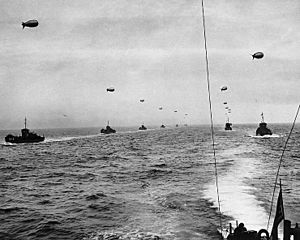
Naval supremacy was essential for amphibious operations, like the invasions of Northwest Africa, Sicily, Italy, and Normandy. The use of Mulberry harbours (temporary harbors) allowed invasion forces to be resupplied. The successful invasion of Europe reduced the Navy's role in Europe to escorting convoys and providing fire support for troops near the coast.
Operations Against Japan
The British Eastern Fleet had moved to East Africa because of Japanese attacks in the Indian Ocean. Despite opposition from the U.S. Fleet Commander-in-Chief Admiral Ernest King, the Royal Navy sent a large task force to the Pacific (British Pacific Fleet). This required new methods, like a large support fleet and resupply at sea, focusing on naval air power. Their biggest attack was Operation Meridian, striking oil refineries in Sumatra to deny Japan oil supplies. The fleet also supported allied forces during the Battle of Okinawa.
If Japan had not surrendered, the Royal Navy would have been part of Operation Downfall in 1946. This planned invasion of Kyushu would have been the largest amphibious landing ever. The Royal Navy would have sent 18 aircraft carriers and 4 battleships.
By the end of the war, the Royal Navy had over 4,800 ships. However, it lost its position as the largest navy in the world to the United States Navy in 1943. The Royal Navy became the second-largest fleet, ending over a century of being the strongest.
Cold War Era (1945-1991)
After World War II, the decline of the British Empire and economic problems in Britain forced the Royal Navy to shrink. Most pre-war ships were quickly retired and sold for scrap. Only the best ships (battleships, carriers, cruisers, and some destroyers) were kept and refitted. The powerful United States Navy took over the Royal Navy's role as a global naval power. The threat of the Soviet Union and Britain's worldwide commitments created a new role for the Navy. Governments had to balance these commitments with rising costs of weapons.
Battleships were quickly removed from service because they were expensive to run and maintain. Their only use after 1945 was to bombard shores. HMS Vanguard (1946) was the last battleship built by any nation. It was nicknamed "Britain’s Mightiest Mothball" because it saw little use. It was decommissioned in 1960. Rear-Admiral John Grant said then that "The battleship is out of date and has now been replaced as a capital ship of the fleet by the aircraft carrier."
A small new shipbuilding program began. Some new carriers were completed between 1948 and 1958. Three Tiger-class cruisers were finished in 1959–61. Daring-class destroyers were built in the 1950s, and County-class guided missile destroyers in the 1960s.
The Navy planned to replace its aircraft carriers in the mid-1960s with three large carriers. But Harold Wilson's new Labour government, which came to power in 1964, wanted to cut defense spending. In 1966, the plan was canceled. Existing carriers were refitted, but they were decommissioned one by one without replacement. By the early 1980s, only Hermes remained and was refitted to operate Sea Harriers. She worked with three much smaller Invincible-class aircraft carriers. The fleet now focused on anti-submarine warfare in the north Atlantic, not worldwide strike capability.
Korean War (1950-1953)
The Royal Navy served in the Korean war as part of the British Commonwealth Forces Korea (BCFK). Britain supported South Korea against invasion from the North. The most important naval battle, the Battle of Chumonchin Chan, happened on July 2, 1950. Four North Korean torpedo boats attacked a fleet of UN Command ships, including HMS Jamaica. All four North Korean ships were sunk in ten minutes. This stopped North Korea from further attacking UN warships.
The war did not have more large ship battles. Navy carriers continued to support aircraft like Supermarine Seafires and Hawker Sea Furies.
Suez Crisis (1956)
Relations between Britain and Egypt had worsened since the Egyptian revolution of 1952. The Egyptian government signed arms deals with Soviet-bloc countries and opposed British goals. Prime Minister Anthony Eden wanted to remove President Gamal Abdel Nasser. When Egypt nationalised the Suez Canal, threatening Western access to this important waterway, Israel invaded Egypt on October 29.
British and French forces had been gathering in the Mediterranean since August. The Royal Navy sent an aircraft carrier group, cruisers, destroyers, frigates, minesweepers, and amphibious ships. The action began with a week-long air assault. On November 6, a naval attack followed, supporting a successful landing.
While the military goals were met, Britain and France faced strong international criticism, even from allies like the United States. The US refused to support the action, which showed how weak Britain and France had become. Britain especially lost its status as a superpower, and this sped up the process of decolonisation. Most of the British Empire broke up within a decade.
Cod Wars (1958-1976)
The Royal Navy was involved in three conflicts with the Icelandic Coast Guard from 1958 to 1976. These were called the Cod Wars and were about fishing waters. Royal Navy ships tried to cut the nets of Icelandic fishing boats. Later, they were equipped to ram Icelandic ships. After Iceland ended diplomatic relations with Britain and threatened to leave NATO, a peace deal was reached. Britain recognized Iceland's control over a large fishing area, which led to thousands of British job losses.
Polaris Programme (1962-1996)
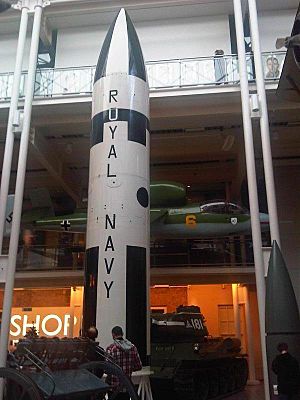
In 1962, a new Dreadnought became Britain's first nuclear-powered submarine. The next year, the Polaris Sales Agreement allowed Britain to buy the Polaris missile from the United States. This was for submarine-based nuclear weapons. The good terms of the deal surprised the British and showed improved relations after the Suez crisis. In 1968, the first ballistic missile submarine Resolution was commissioned with these new missiles. The Royal Navy later became fully responsible for Britain's nuclear deterrent.
Polaris-armed submarines patrolled the North Atlantic from 1968 to 1996. The Polaris program was eventually replaced by the newer Trident system.
Beira Patrol (1966-1975)
With UN support, Britain placed sanctions on Rhodesia (now Zimbabwe) after it declared independence without racial equality. When Rhodesia tried to get oil through the port of Beira, the Royal Navy began a nine-year blockade of the port. Navy personnel questioned oil tankers, and later were allowed to use force against uncooperative tankers. About 80 Royal Navy ships were involved. The operation ended after Mozambique gained independence in 1975.
The patrol was costly and difficult, and it failed to achieve its goals. It is sometimes called a "cautionary tale."
Falklands War (1982)
The most important operation by the Royal Navy after World War II was defeating Argentina in the Falkland Islands War in 1982. Just four days after the invasion on April 2, a Task Force sailed to the South Atlantic. On April 25, the Navy recaptured South Georgia, damaging an Argentine Navy submarine. Despite losing four naval ships and other civilian ships, the Royal Navy showed it could still fight a battle far from Great Britain. HMS Conqueror is the only nuclear-powered submarine to have attacked an enemy ship with torpedoes, sinking the Argentine cruiser ARA General Belgrano.
Operations After 1982
In the later stages of the Cold War, the Royal Navy was set up with three anti-submarine warfare (ASW) aircraft carriers and many frigates and destroyers. Its purpose was to find and destroy Soviet submarines in the North Atlantic. There were also mine countermeasures and submarine forces. As the Cold War ended, the Royal Navy fought in the Gulf War against Iraq. Its Sea Skua anti-ship missiles sank many Iraqi Navy ships.
Since 1991
With the end of the Cold War and the Soviet submarine threat, the Royal Navy's goals changed a lot. Major cuts were made in the following decades. About half of the submarine fleet was removed by 1995. The WRNS joined the Royal Navy in 1993. The Strategic Defence Review of 1998 further reduced the size of the surface fleet.
The British military intervention in the Sierra Leone Civil War showed that Britain needed to project power outside the Middle East. This led to the 2003 paper "Delivering Security in a Changing World." It promised a brighter future for the Navy, with the largest naval building program since World War II. The goal was to update the fleet and change it from an anti-submarine force in the North Atlantic to a true blue water navy again. While some smaller ships were removed, two new large aircraft carriers were confirmed. New and more capable ships were built, like the Sheffield-class destroyers and various frigates. But they were never built in the same numbers as the ships they replaced. So, the Royal Navy surface fleet continues to shrink.
From 2001, Britain became involved in several long conflicts in Afghanistan, the Middle East and North Africa, including Syria, Iraq, and Libya. These wars largely came from the September 11 attacks and the Arab Spring. Some are part of the global war on terrorism.
Trident Programme (1994-Present)
The Trident program was designed in the later Cold War to replace the Polaris missile. It was meant to defend against an attack from the Warsaw Pact nations. But the Warsaw Pact disbanded by the time the first Trident missiles entered service in 1994, aboard HMS Vanguard. After the WE.177 bomb was retired in 1998, Trident became Britain's only nuclear program. The submarines are based at HMNB Clyde in Scotland. The program has faced public opposition, especially from the Scottish National Party. The UK parliament voted to renew Trident in 2016, extending it into the 2030s.
Sierra Leone (2000)
The Sierra Leone Civil War (1991-2002) saw a short British military intervention in 2000. HMS Norfolk was stationed nearby from 1999 due to humanitarian concerns. A larger Royal Navy fleet supported UN troops in late 2000 but stayed only a few weeks. The intervention showed problems with post-Cold War naval policy that had not been addressed. This was one reason for the change in naval policy in the 2003 paper "Delivering Security in a Changing World."
Afghanistan (2001-2014)
An international group invaded Afghanistan after the September 11 attacks. Since Afghanistan is a landlocked country, the Navy was less involved than other parts of the British armed forces. However, 1,000 Navy personnel were sent to Helmand Province in 2008 due to a shortage of specialist troops. Navy personnel worked in support roles like radio operators, drivers, and medics. From 2006 to 2014, they also repaired aircraft. All troops from Helmand were withdrawn in 2014.
Iraq War (2003-2011)
The Navy took part in the 2003 Iraq War as part of Operation Telic. It was involved in the 2003 invasion and the later period of fighting. Royal Navy warships bombarded positions to support landings by Royal Marines. HMS Splendid and Turbulent (S87) launched Tomahawk cruise missiles at targets in Iraq. In later stages, the Navy trained Iraqi sailors.
The war also saw two incidents where Iranian forces captured Royal Navy personnel in the Persian Gulf. In 2004, Iranian armed forces took Royal Navy personnel prisoner on the Shatt al-Arab river. They were released three days later. In 2007, Iranian forces again took Royal Navy personnel prisoner from HMS Cornwall. They were released thirteen days later.
While most British forces left in 2009, 81 Royal Navy personnel stayed in Umm Qasr for training until their final withdrawal in 2011.
Strategic Review Cuts (2010–2020)
The Navy faced big cuts after the Strategic Defence and Security Review 2010, during a time of austerity in the United Kingdom. The review reduced personnel by 5,000 to 30,000. A 2013 report said the Navy was already too small and Britain would need allies if its territories were attacked. These losses were partly eased in the 2015 review, which added 400 personnel. The surface fleet was reduced by 9 ships to 19. The decommissioning of the Ark Royal was moved up to 2011. This left the Navy without an aircraft carrier for the first time since 1918. Capability was restored with the commissioning of HMS Queen Elizabeth in 2017.
First Libyan Civil War (2011)
The Royal Navy was part of the military intervention in Libya. The operation began on March 19. The Navy launched submarine missile strikes, especially early in the fighting. It also evacuated civilians. HMS Liverpool was attacked by a shore battery, the first time a Royal Navy ship had been fired at since the Falklands War in 1982. Liverpool destroyed the battery and a munitions convoy. The operation ended on October 31, after the death of Gaddafi.
War on ISIL (2014-Present)
The rise of the Islamic State of Iraq and the Levant in 2014 led to British military intervention under Operation Shader. This brought the Royal Navy back to Libyan and Iraqi waters. In Libya, it evacuated civilians. In Iraq and Syria, it supported air strikes. During early fighting, HMS Defender escorted the USS George H W Bush in the gulf. Other ships operated from the Mediterranean.
Trends in Ship Strength
The Royal Navy has gotten much smaller since the 1960s. This shows that the country needs fewer ships now. This table does not show how much more advanced the Navy's ships have become. But it does show the general reduction in numbers. The table below shows how the number of different types of ships has changed since 1960.
| Year | Submarines | Carriers | Assault ships | Surface combatants | Mine countermeasure vessels | Patrol ships and craft | Total | ||||||||
|---|---|---|---|---|---|---|---|---|---|---|---|---|---|---|---|
| Total | SSBN | SSN | SS & SSK | Total | CV | CV(L) | Total | Cruisers | Destroyers | Frigates | |||||
| 1960 | 48 | 0 | 0 | 48 | 9 | 6 | 3 | 0 | 145 | 6 | 55 | 84 | ? | ? | 202 |
| 1965 | 47 | 0 | 1 | 46 | 6 | 4 | 2 | 0 | 117 | 5 | 36 | 76 | ? | ? | 170 |
| 1970 | 42 | 4 | 3 | 35 | 5 | 3 | 2 | 2 | 97 | 4 | 19 | 74 | ? | ? | 146 |
| 1975 | 32 | 4 | 8 | 20 | 3 | 1 | 2 | 2 | 72 | 2 | 10 | 60 | 43 | 14 | 166 |
| 1980 | 32 | 4 | 11 | 17 | 3 | 0 | 3 | 2 | 67 | 1 | 13 | 53 | 36 | 22 | 162 |
| 1985 | 33 | 4 | 14 | 15 | 4 | 0 | 4 | 2 | 56 | 0 | 15 | 41 | 45 | 32 | 172 |
| 1990 | 31 | 4 | 17 | 10 | 3 | 0 | 3 | 2 | 49 | 0 | 14 | 35 | 41 | 34 | 160 |
| 1995 | 16 | 4 | 12 | 0 | 3 | 0 | 3 | 2 | 35 | 0 | 12 | 23 | 18 | 32 | 106 |
| 2000 | 16 | 4 | 12 | 0 | 3 | 0 | 3 | 3 | 32 | 0 | 11 | 21 | 21 | 23 | 98 |
| 2005 | 15 | 4 | 11 | 0 | 3 | 0 | 3 | 2 | 28 | 0 | 9 | 19 | 16 | 26 | 90 |
| 2010 | 12 | 4 | 8 | 0 | 3 | 0 | 3 | 3 | 24 | 0 | 7 | 17 | 16 | 23 | 78 |
| 2015 | 10 | 4 | 6 | 0 | 0 | 0 | 0 | 3 | 19 | 0 | 6 | 13 | 15 | 23 | 70 |
| 2020 | 11 | 4 | 7 | 0 | 2 | 2 | 0 | 2 | 19 | 0 | 6 | 13 | 13 | 30 | 77 |
- 'Patrol ships and craft' as of 2020 include: 7 Offshore Patrol Vessels, 3 Survey Ships, 1 Survey Motor Launch, 1 Icebreaker and 18 Patrol Boats.
- Current figures do not include the 13 main support ships used by the Royal Fleet Auxiliary. These ships provide supplies, maintenance, and transport.
- 1701–1713 War of the Spanish Succession
- 1718–1720 War of the Quadruple Alliance
- 1740–1748 War of the Austrian Succession
- 1754–1763 Seven Years' War
- 1775–1783 American War of Independence
- 1793–1802 French Revolutionary Wars
- 1803–1815 Napoleonic Wars
- 1808–1856 The West Africa Squadron stops the Atlantic slave trade.
- 1812–1814 War of 1812
- 1821 First paddle steamer for support use.
- 1827 Battle of Navarino is the last fleet battle between wooden sailing ships.
- 1839–1842 Opium War
- 1840 First screw-driven warship, Rattler.
- 1853–1856 Crimean War
- 1856–1860 Second Opium War
- 1860 First iron-hulled armored battleship, Warrior.
- 1902 First British submarine, HMS Holland 1.
- 1905 First steam turbine-powered "all big-gun" battleship, Dreadnought.
- 1914–1918 First World War
- 1918 First true aircraft carrier, HMS Argus.
- 1918–1920 Russian Civil War
- 1931 Invergordon Mutiny
- 1939–1945 Battle of the Atlantic
- 1940 Norwegian Campaign
- 1940 Dunkirk evacuation
- 1940–1944 Battle of the Mediterranean
- 1941–1945 Arctic Convoys
- 1941–1945 South-East Asian Theatre
- 1944 Normandy landings
- 1944–1945 British Pacific Fleet
- 1946 Corfu Channel Incident
- 1949 Amethyst incident on the Yangtze River.
- 1950–1953 Korean War
- 1956 Suez Crisis
- 1958–1976 Cod Wars
- 1959 The last battleship, Vanguard, is removed from service.
- 1962–1966 Indonesia–Malaysia confrontation
- 1963 First British nuclear submarine, Dreadnought.
- 1966–1975 Beira Patrol against Rhodesia.
- 1977 Operation Journeyman to guard the Falkland Islands.
- 1980–2002 Armilla patrol in the Persian Gulf.
- 1982 Falklands War
- 1991 First Gulf War
- 1999 Operation Allied Force – Kosovo conflict
- 2000 Operation Palliser – Sierra Leone
- 2001–2014 Operation Herrick – Afghanistan Campaign
- 2002–present Combined Maritime Forces in the Indian Ocean
- 2003–2009 Operation Telic – Invasion of Iraq
- 2011 Operation Ellamy – Libyan Civil War
- 2014–present Operation Shader – Military intervention against the Islamic State of Iraq and the Levant
See also
- Articles of War (Royal Navy) replaced by the Armed Forces Act 2006
- History of the Royal Marines
- History of the Royal Naval Reserve
- List of ships and sailors of the Royal Navy
- List of all naval vessels current and former of the United Kingdom
- Maritime history of the United Kingdom
- Naval history


